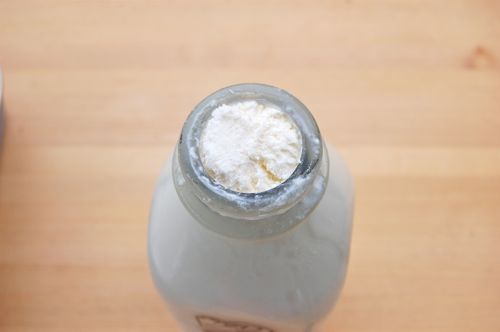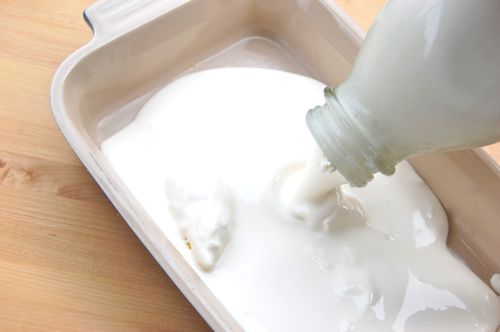Joe’s Clotted Cream Adventure Begins
Most days I’m one of those cynics who thinks the local foods movement is overdone. Oversold, over-hyped, overwrought…over pretty much everything. But today is not one of those days. Why? Because this morning I opened up a glass bottle of locally-produced cream and found this:

Clotted cream. A big fat plug of the stuff, sitting right at the top of the bottle. How thick a plug? Check this out:

That’s whole bunch of mud-thick dairy fat. It took a spoon to jimmy it out of there so I could pour the bottle out into my little baking dish here:

That’s one of the glories of un-homogenized cream, friends. Right now the whole mess is heating in a 185-degree Fahrenheit oven, where it’ll stay for about 10 hours. Then into the fridge overnight. Hopefully by the morning I’ll have an entire dish of fresh-made Kentucky clotted cream to eat with my leftover scones. Oh, happy day!
I never thought about doing this before, mostly because I’ve never had access to fresh, un-homogenized cream. Keep your fingers crossed that the experiment works!
Fresh dairy is so much better than the grocery store stuff! I get raw milk(legally!!) from a local farmer and I could never go back to the store stuff. Yum.
Whoa. Raw milk takes things a bit too far for me. I’m a BIG believer in Mr. Pasteur. However I’m in agreement that small dairies…rock. Thanks for the note, Louisa!
– Joe
It’s not for everyone-I’m not a pusher of raw milk as healthier, but man does it taste better!!
I’d really like to see the results of a blind tasting of various kinds of milk. For several years I lusted after some unpasteurized milk from grass-fed cows, convinced that it would make me swear off the industrial product sold by grocery chains under the label “milk”. Well, last year I had my chance. In France, no less. I visited a small dairy and sampled the milk collected that very morning from their grass-fed cows. To my great surprise, I could taste no difference compared to milk from my local big box grocery. Maybe someone with finer sensibilities than me could tell the difference, but still it would have been minor. I was so disappointed.
Hey Dan!
You see the reason for my cynicism! 😉
However my guess is that if you tried them side-by-side you’d probably notice a difference. But that’s the thing: how many of us really sit down to concentrate on tasting a glass of milk…or an apple, or a bowl of peas, or some sliced chicken breast, or salt, or carrots, or olive oil…you follow me. The vast majority of the time the groceries that we get from conventional sources are more than up to the task of pleasing us. Looked at objectively, our local supermarket is a hall of wonders, filled with foods of a freshness and quality undreamt of just a few decades ago.
Are there times when the ultra-fresh/organic/heirloom product makes a difference? I believe so: anytime you want to make a particular ingredient the star of a dish. Fresh, locally-produced cream makes a knockout panna cotta, for example. The rest of the time the products you find in the supermarket are more than acceptable. Taken all together, the food choices we enjoy today are absolutely stunning. I want to say we’re all spoiled rotten, but I’ve said that too many times before! Thanks for letting me rant, Dan!
Cheers,
– Joe
I have done a side-by-side taste test with American grass-fed milk (pasteurized and homogenized) and “regular” supermarket milk, and I noticed a significant difference. The grass-fed milk was noticeably “grassy” to me, which my wife found unpleasant but I did not. The co-op from which I bought the milk processed it into whole, skim, 2-percent, etc., so on that count it was not notably more or less creamy than the “regular” stuff.
I have now been living in Belgium for the past 4 years and have a guy from whom I buy pasteurized, unhomogenized whole milk, and holy cow is there a difference compared to supermarket milk! It frequently comes with the big plug of cream in the top like Joe shows in his picture.
To be fair, part of the reason there is such a big difference compared to the supermarket milk here is that the supermarket milk is truly awful. Nearly all of it is not just pasteurized and homogenized, but ultra-pasteurized and sterilized such that it can be packed in tetra-packs and stored at room temperature for months on end.
All that said, I might not be the best guy to comment on the taste of anybody’s milk — I don’t really drink the stuff very often. I use the ultra-pasteurized stuff when I just need a small amount for cooking, and buy the good stuff for cheesemaking (ultra-pasteurized milk does not curdle well and is useless for cheesemaking).
Joe,
Since you’re the closest thing I know of to a food scientist on this website (heh), I’ll ask you:
First, my understanding is that Pasteurization is essentially heating a thing enough that the microbes in or on it die, and the heating can be either lower in heat and longer in time, or faster and hotter. Have there been any studies about the differences in the final product from the two extremes of the method? Scientific, if you please. I’ve heard plenty of anecdotal/apocryphal “evidence” from the “local” movement that the low/slow method preserves enzymes and whatnot.
Hey Ed!
I’m not totally sure what you’re asking. Are you asking if there have been any scientific studies regarding the taste of the final product? Or are you wondering more about nutrients or performance.
– Joe
hey neat! the same thing (or at least, a similar thing) happens to me when i buy heavy cream from trader joe’s. if i let the carton sit for just a couple days in the fridge, bam – solid on top. i don’t know if it’s specific to their brand, but i haven’t had that happen with other grocery store varieties. i’ve considered it pseudo butter, but glad to know that it’s actually clotted cream. same dif as far as i’m concerned- i’m happy to have it around.
Amen, Yasmin! It’s excellent on toast!
– Joe
When I was a kid (back in Maryland) we got our milk from a large dairy where the cows were grass fed. I remember warily tasting the milk when spring arrived. Apparently, wild chives would get in the grazing fields from time to time and the flavor would come through in the milk. It was gross. I can’t imagine why they went ahead with pasturizing and selling it as my Mom always demanded a refund. I’ve never been even slightly tempted to seek out grass fed cow milk based on that experience and wonder if that still happens occasionally and if so, what they do about it. It’s got to be very costly to the dairy.
Fascinating. But it makes a lot of sense. You are what you eat, even and especially if you’re a cow. I wonder how that’s managed these days…
Thanks Susan!
– Joe
When I lived in Kansas City, I was able to get raw milk once a week from a small farm outside town. I noticed a few big differences. The milk lacked a refrigerator taste, probably because it was stored in glass jars. (My husband learned to enjoy milk without chocolate.) It made thicker yogurt and kefir, perhaps because there was more protein in the milk. There were a couple of weeks in the spring where the milk tasted wonky, but not really noticeable when cooking with it.
However, the huge difference was in the cream and butter it produced. I never could get it to make whipped cream, but that may have been because I skimmed the cream myself, and didn’t let it sit long enough. I did find it worth my time to make my own butter (for eating, not baking). It had an incredible flavor, and was so yellow, it looked like cheese. In fact, when I took some bread and butter to work, one woman presumed just that, and proceeded to cut off about an ounce to eat with her small slice of bread. The butter also changed with the seasons. Since the butter wasn’t “aged” when processed, it would go from smooth and spreadable in the summer, to firmer and more crumbly in the winter.
I’ve found that (especially for the price) I don’t need such wonderful dairy every day, but when I bake bread, I really wish I had some of that golden yellow butter!
You nailed it, Catherine! The good stuff is great…and a true gift at the right time and in the right place. It’s not really needed every day, but how great is it to have access to something like that when you want it? Thanks for the email!
– Joe
I can certainly discern the difference between raw milk and supermarket milk! I’ve been drinking raw milk for a year now and when I drink supermarket milk these days I can really taste the ‘commercial-ness’ in its taste. And I DO savour everything I put into my mouth! haha
Yow. I don’t think I’m alone when I say that drinking raw milk poses a significant health risk, so you won’t find me condoning it. But in general I do feel there’s a different between ultra-pasteurized grocery store milks and low-heat pasteurized and un-homogenized milk, but I have no doubt that the difference varies from batch to batch, dairy to dairy and region to region. There are so many variables when it comes to milk (environment, cow diet, etc.) that it probably isn’t possible to perform a truly scientific evaluation of the differences. Anecdotes and personal judgement a probably all we have. Thank Henry!
– Joe
Jimma-
Actually Bridget at http://www.crumblycookie.net (an excellent blog) lives in AZ and therefore only has access to UHT milk. She has posted a recipe for ricotta, and has had good results for that cheese, it forms curds and everything. So you can use UHT to make cheese, and it’s remarkably better (and cheaper) than store bought. I (nor Bridget) haven’t tried making a more complicated cheese than that, so I can’t comment on those.
Great stuff, Elle! Thank you!
– J